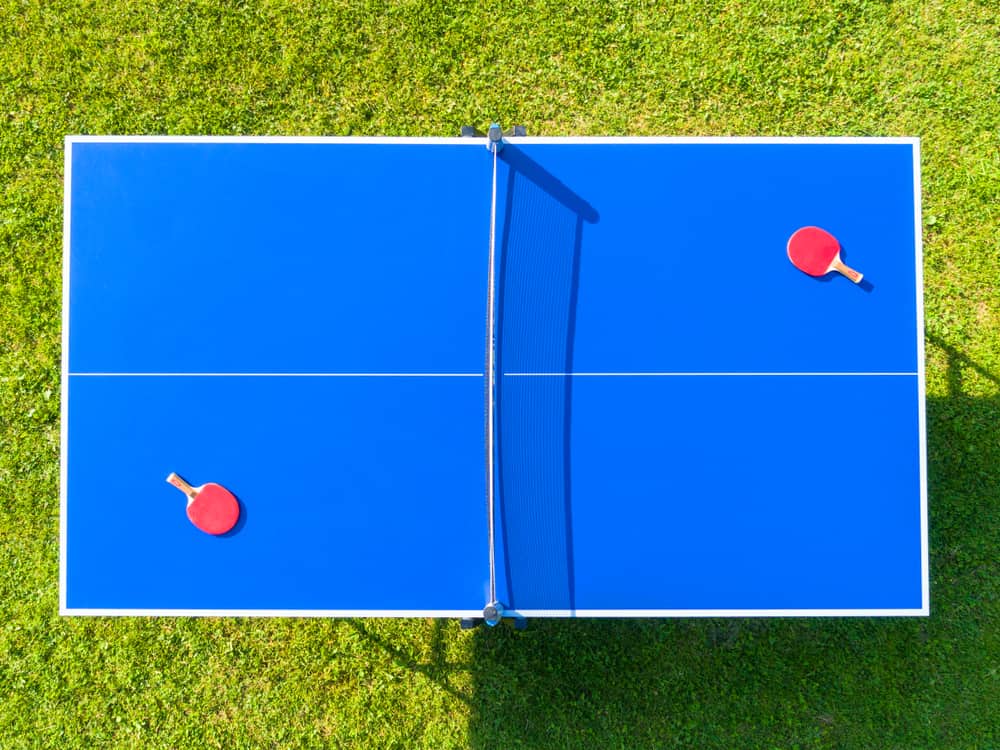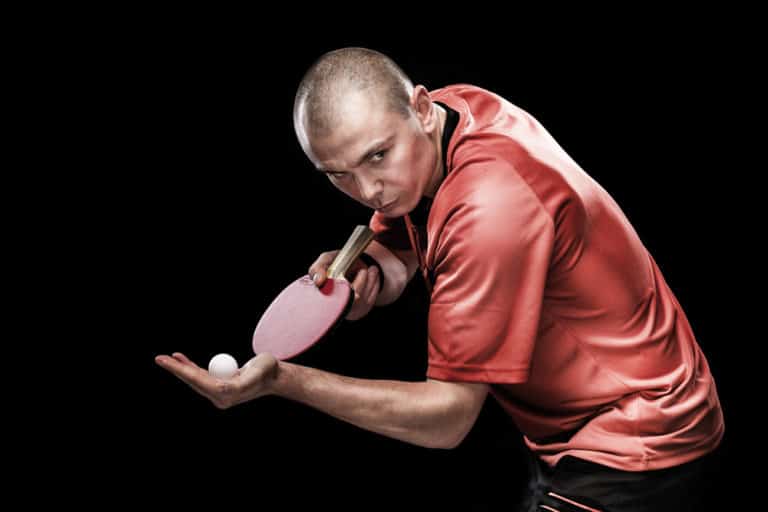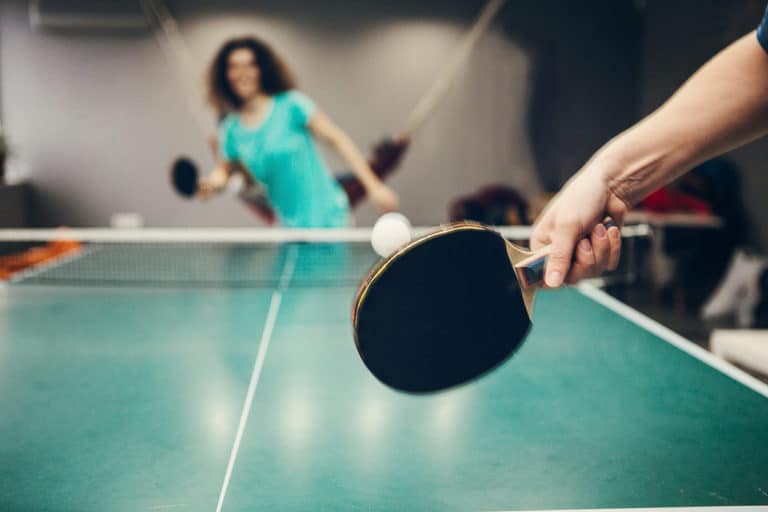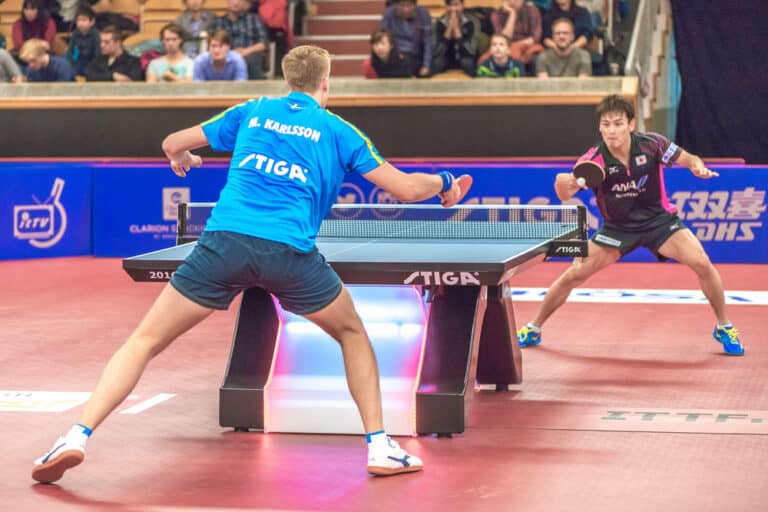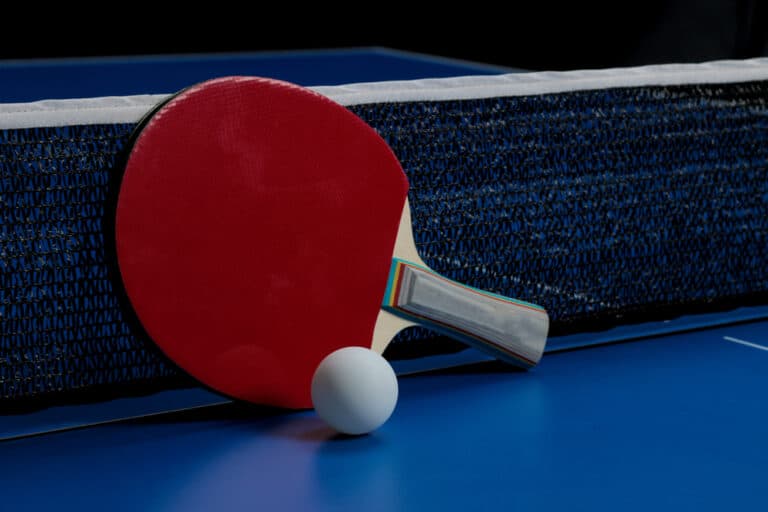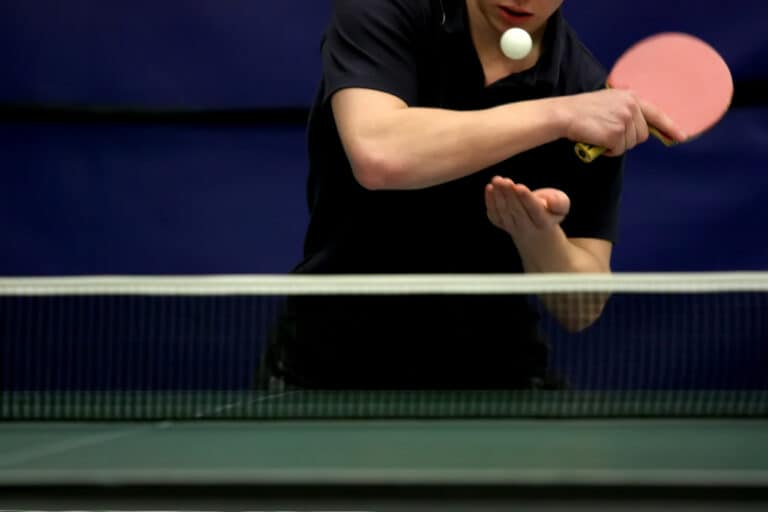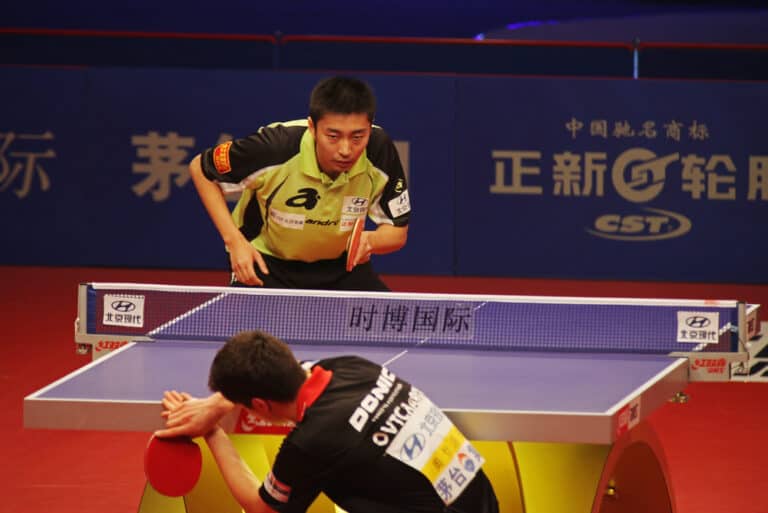What Is The Best Surface For Table Tennis?
Table tennis is played on various surfaces, including simple dining tables in many homes. But that isn’t the only surface that’s important. We have to consider the other surfaces of table tennis, including the surfaces of the table, floor, and racket. With all the variations, what is the best surface for table tennis that consistently gives the best bounce and power?
The best material for the surface of a table tennis table is fiberboard. The table’s surface should be pretty thick with a smooth upper surface because even the quality of the paint and how it’s applied to the table will all change the way the ball reacts and bounces once it is in play.
Any table tennis player who knows what they are talking about will tell you that the thickness and the materials used for the final surface of the table will ultimately determine how good a table tennis table is. There are way too many variable factors to be able to answer it simply, so let’s examine every aspect in more detail.
Requirements For The Best Table Tennis Surface
With the variety of table tennis tables out there, how on earth do you determine if you are choosing and buying the right table for your requirements? Though the ITTF (International Table Tennis Federation) does not have set rules about the materials to be used for the upper surface of the table, once you have played on the best table tennis surface, no other surface will suffice.
When you are out shopping for a table tennis table, you are probably looking for equipment that will not bankrupt you, but you also want quality. A major determining factor should be the surface thickness. The thicker the playing surface of the table, the better your game will be. Thicker surfaces generally lead to higher density, which increases the bounce and speed of the table tennis ball.
This might seem obvious, but you also want a flat surface. A table tennis surface that is full of bumps and bends simply won’t suffice. So, you do not want to invest in a table that will warp after a few years. You want something that could last a lifetime. The thickness will help with this, but the materials are also crucial.
As we go deeper into the mechanics of how the ball must react to the surface of the table tennis table, we know that only the best will actually suffice. This involves a delicate balance between the building material of the table, how thick the surface wood should be, and the paint used on the table’s surface to give the best results and let you play your best game.
When we look at the manufacturing process, you will soon notice that not all tables are equal in quality (as with almost any product you can think of). As we all know, you can easily find several knock-off products that are manufactured cheaply, but in the long haul, you will actually find that you wasted a lot of money by sacrificing quality.
You want a table that is made to exceptional manufacturing standards so that it will not warp and damage over time. The absolute best decision that you can make for yourself and your family is to invest once in a table tennis table that will give you enjoyment for a lifetime. It really is worth the added expense.
Another question you should ask yourself beforehand is whether you want it for indoor or outdoor entertainment. As table surfaces are not made equally, you will find that not all tabletop surfaces will withstand the harsh outdoor conditions that the table will be exposed to. Indoor tables require different materials and treatment processes than those made for indoor use.
In summary, when shopping for the best table tennis table, the factors you should keep in mind are the surface manufacturing materials, the thickness of the top surface, and the top coating’s quality and application technique. The top coating has the purpose of giving the table durability and improved performance.
So, what materials are used to manufacture the best table tennis tables in the world?
What Is The Best Material For A Table Tennis Surface?
As we have seen, according to the ITTF, the playing surface can consist of any material; there are no clear regulations against any material. Even if you can manage to play on a sponge, the ITTF is okay with that, too. The only factor you must account for is that the ball must react and bounce consistently when you drop it onto any part of the table’s playing surface.
After years of experimentation, manufacturers find that the best material to manufacture table tennis table surfaces is a very highly condensed fiberboard, which means that not every fiberboard material will be sufficient. Most fiberboard isn’t dense and solid enough and will not give you the results you want. All materials play a significant part in the quality of the table tennis surface.
For instance, a table tennis table that will be used outside should not be primarily made of wood since the wood will warp quickly due to the environment, humidity, and weather conditions.
However, there are tables that are manufactured with the best materials (still made of wood) that can withstand the harsh conditions outside. They are manufactured with a wooden core and a weatherproof aluminum outer shell surface to keep the moisture from affecting the wooden core in any way, thereby avoiding the warping problem entirely.
So, in summary, you should aim to get a table tennis table with a dense fiberboard surface, but if you plan to use it outdoors, ensure that it has a seamless aluminum coating around the plywood. You can find tables that are specifically rated for outdoor use.
How Thick Should A Table Tennis Surface Be?
Another crucial factor you should seriously consider is the thickness of the table’s surface. If you do your research, you will find that the thickness of the tables’ surfaces generally ranges between half an inch and one inch.
Never purchase a table that has a top surface less than ¾ inches (about 19 to 20 millimeters) in thickness. Anything less than ¾ inches will warp more quickly, giving you the dissatisfaction of a ball that bounces inconsistently and changes direction at random. Sometimes you won’t even notice the warping in the beginning, but the erratic movement of the ball is hard to ignore.
You are ultimately looking for a playing surface that is consistent when you drop a standard table tennis ball onto the surface of the table. When dropped from about 12 inches (30 centimeters) above the table, the ball should bounce consistently and without breaking a steady bounce of about 9 inches (23 centimeters), regardless of where on the table you drop the ball.
This means that if you are looking for the best surface possible, you should look for a table surface between 22 millimeters and 25 millimeters thick (about 0.87 to 0.89 inches). One more aspect you should keep in mind is that, with these thicker table tennis tables, you are also paying more, but that should go without saying when you’re looking to buy the absolute best.
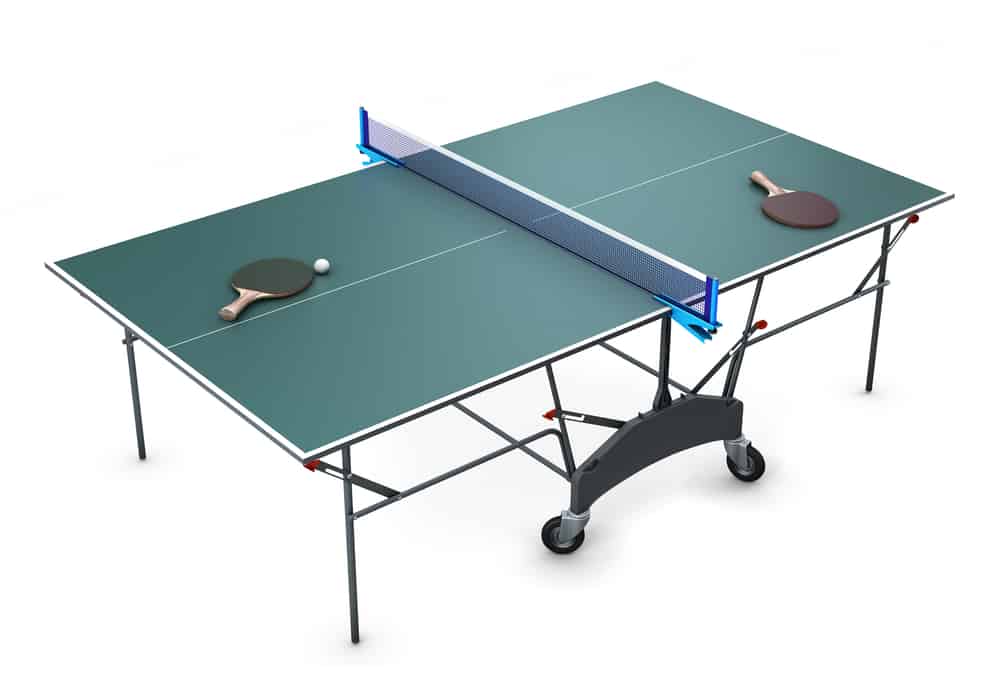
The Best Top Coating For A Table Tennis Surface
When we consider the best top coating for a table tennis surface, again, there are no set rules according to the ITTF, except for stating that it is best if the surface is coated with a matte layer and coated uniformly in one dark color, either green or blue.
The matte finish is crucial because any other finish will be too reflective and cause problems with the ball’s visibility. Similarly, the green or blue color will ensure that the ball is clearly visible from any angle, regardless of where on the table it is located. The green or blue matte finish coating ensures that players will have no problem spotting the ball.
As mentioned, a top surface of one inch is best, and you should not consider buying a table if it has less than the one-inch top surface. Keep in mind that this should include the top coating. So the thickness of the surface, combined with the top coating, should ideally be one inch thick as this will give you the same experience as a table that the ITTF approves for tournaments.
The top coating of the table is commonly finished off with Alkyd paint, which is mainly used because of its resistance to abrasion and scratching, and the finish can last for a long time. This paint can be applied to multiple different surface types, which makes it versatile as a table tennis table can have many different materials to which this paint can be applied.
An Example Of A Table That Has The Best Surface
Joola Signature Pro Tournament Indoor Table Tennis Table
This table is an excellent example of all the characteristics you need to look for in a table tennis table. We have a table with a surface thickness of 25 millimeters made of medium-density fiberboard, providing you with that consistent and accurate bounce.
Also, with the density and thickness of the surface, there won’t be too many vibrations moving through the ball, which will also ensure a precise bounce. The Joola Signature Pro is certified by the ITTF, so you know that this table fulfills all of the requirements and will prepare you for the pros if that’s what you’re going for.
The Best Surface For Table Tennis Flooring
When we mention table tennis surfaces, the first thing we think about is the surface on which the game is played, i.e., the table. But that’s not the only crucial surface to consider. As with all high-energy sports, the surface you’re standing and moving on is also vital.
Players want to feel comfortable, knowing they won’t slip and fall, missing that critical shot. That is why floor surfaces are just as important as any of the other table tennis surfaces. So, what is the best floor surface for table tennis?
We know that table tennis requires quick thinking and swift foot movements. Anybody who doubts that hasn’t watched enough professional table tennis matches. That is why it is vital to install a durable, slip-proof floor surface that can withstand plenty of high-energy table tennis activities.
The floor should also be able to support our bodies, swift actions, and friction, not to mention the heavy weight of the table tennis table, which brings the quality of the floor surface into question. Any floor surface that cannot withstand this kind of abuse is not the best and will never be good enough for a serious player.
The best floor surface must be durable, easy to maintain, and keep clean, and it should be able to withstand scratches, wear, and tear.
With all the above factors in mind, it’s best to look for a vinyl table tennis floor, which you can find at most sports shops (often sold as interlinking tiles). This surface can withstand years of wear and tear, even with extreme activities such as table tennis. Applying this vinyl flooring to a hard cement floor will give you the best floor surface possible for table tennis.
The Best Surface For A Table Tennis Racket
A table tennis racket has two components that you should consider: the blade (the wood or plastic base surface) and the rubber surface that coats the blade. Plastic blades are not the best option since they tend to be weaker and less resilient. If you’re at all serious about how well you can play table tennis, only wooden blades will do.
The surface coating should either be a dense rubber or carbon Kevlar. It should be sturdy enough to reflect the ball effectively but still have just enough spring to it for the ball to bounce off it properly.
An Example Of Table Tennis Rackets With The Best Surface
Joola Infinity Balance Table Tennis Racket
The Joola Infinity Balance racket is one of the best table tennis rackets you will find on the market. It is manufactured from the highest quality wood, which is a combination of Limba, Kiri, Ayous, and Koto wood, and coated with dense rubber.
This racket gives a player a lot of spin, speed, and control. It actually comes with a performance rating of 92% for speed, spin, and control. This racket is for players who are looking to up their game and ascend to more advanced levels of playing.
Joola Infinity Overdrive Table Tennis Racket
The Joola Overdrive is the racket with the best surface material and the highest performance rating. However, this racket is more suited to more advanced players. It has two layers of carbon Kevlar which reinforces the racket’s wooden surface, decreasing the racket’s vibrations and giving you more robust returns.
Also, the best wooden materials (Koto, Hinoki, Ayous) are combined with the two layers of carbon Kevlar to equip the player with more speed and spin from the racket. The performance rating on this racket is 100% for speed, 99% for spin, and 92% for control. It is an exceptional racket.
If you can handle the heat, speed, and spin from this racket, you should definitely consider it, as this can help set you up as an exceptional table tennis player.
Conclusion
A table tennis table is a considerable investment. The best advice is to shop around, read reviews, and compare all the tables you look at with these specifications. Also, remember that a good table tennis table is great, but you should not neglect the other factors, like the floor surface and proper rackets, and of course, practice, practice, and more practice.
References
- https://www.amazon.com/dp/B07K3HBJHX/
- https://www.amazon.com/dp/B07K3HRPWZ/
- https://www.britannica.com/sports/table-tennis
- https://homeguides.sfgate.com/repair-pingpong-table-surface-95089.html
- https://nymag.com/strategist/article/best-ping-pong-tables.html
- https://www.gym-flooring.com/blogs/news/top-tips-for-buying-table-tennis-flooring

